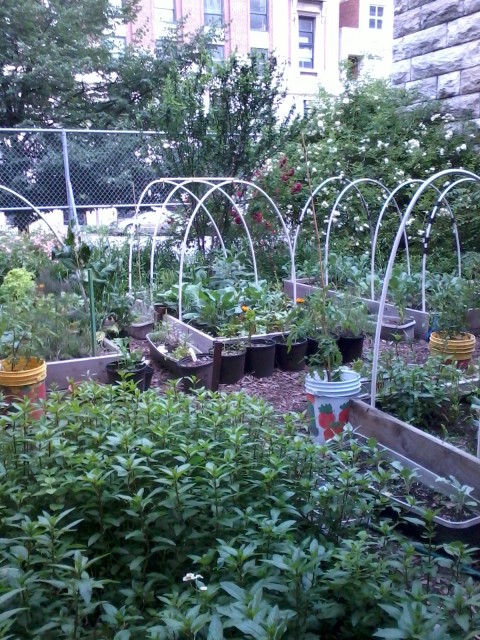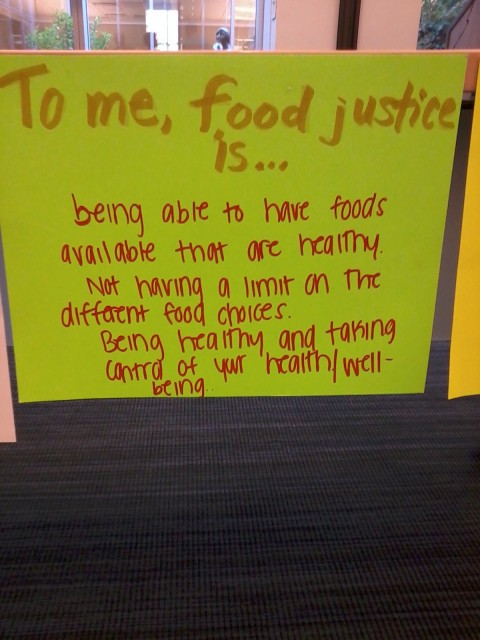
Columbia Secondary School’s Community Garden
Professor Hill’s sixth-grade classroom at the Columbia Secondary School is full of mason jars, cooking implements, herbs under indoor plant lighting, dried flowers, and at one point, a small pen for baby chicks in the corner of her classroom. For her, these tools are anything but classroom trinkets. The pots and pans clustered in the corner of the classroom are used in her sixth-grade elective class, which educates students on food security, food systems, and urban agriculture. Students follow a food justice curriculum and later apply what they learn in the school’s community garden.
This week, Professor Hill has hosted four days of Garden to Table workshops for 96 sixth-grade students as a culmination of the food justice curriculum. The workshops feature tutorials on how to make pizza from every stage of the process, from dough-making to harvesting pizza toppings in the garden to making fresh mozzarella cheese.

Students harvested basil, oregano, chives and chocolate mint from the school’s garden to add to their homemade pizzas and salads. For some students who have been active in the school’s community garden for the past few years, just being able to harvest herbs is a feat. These students have witnessed how the the garden has confronted many challenges that urban gardens often face: high lead content in the soil, invasive insects, and costly safety regulations that forced their move from the roof of Columbia Secondary School to a vacant lot on 119th and Amsterdam Avenue.
Despite these challenges, the middle-schoolers demonstrate a remarkable level of determination and foresight on how urban gardens can shape New York City’s future. Garrison Koch, a sixth grader at CSS, said that getting even more rooftop gardens off the ground could be the next step toward a more food-friendly New York City, while also recognizing the caveats of doing so:
Rooftop gardens would work well for us because it would maximize space. And that’s what New York is about, you know, making the most out of what we have… But it’s hard because a lot of buildings are either home or work, and people don’t really want people that they don’t know working on a farm on their roof…To try to get [gardening] everywhere would be hard because not everyone would be really into it.
Columbia Secondary School is just one of many New York City public schools putting a new spin on the traditional classroom experience–many are incorporating food justice topics into their curriculum and bringing class outdoors.
On June 12, Hunter College’s Silberman School of Social Work hosted an event in celebration of youth involvement in the food justice movement. A number of the city’s youth empowerment programs attended, including the Youth Leadership Program, the Children’s Aid Society, and Motivating Action through Community Health Outreach (MACHO).
P.S. 211, a bilingual magnet school in the Bronx, has created their own community cookbook, featuring simple, healthy recipes and desserts with a reduced sugar content. Students from P.S. 211 said that publishing a bilingual cookbook in English and Spanish is important because it helps to reach more populations living with fewer healthy food options.
Students from the Youth Leadership Program have launched their very own PhotoVoice Project. The project encourages students to interact with local store vendors and community members in Harlem to examine different food options in the area. Students catalogued interviews with workers from food trucks, street vendors, bodegas, and mini-marts and took photos of their neighborhood food options. The common theme? There are precious few healthy food options in the neighborhood.
The photos from the PhotoVoice Project show a visual connection between the spatial dispersal of healthy food options and race and class-based inequalities. It is not new news, but always worth highlighting the fact that stores providing fresh ingredients are more heavily concentrated in higher-income neighborhoods.
All of these kids recognize the food justice challenge in New York City, and they are making a lot of noise to change it by engaging and examining their surrounding food options. As one student told me, “We want our kids to enjoy the fruits of our labors.”
Photos: Jennifer Davis
